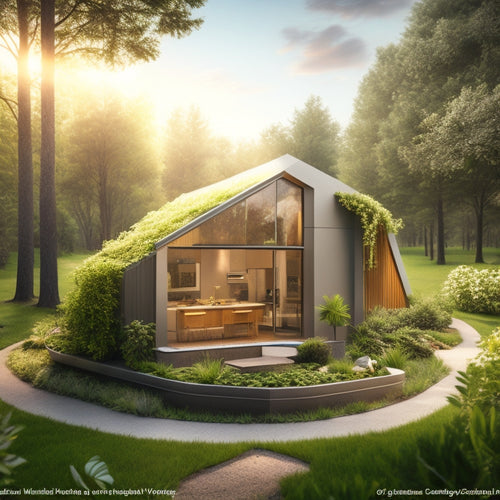
Maximize Home Energy Efficiency: Power Management Mastery
Share
You're taking control of your home's energy efficiency, and with the right strategies and tools, you can dominate power management to greatly reduce energy waste and costs. Start by utilizing smart power strips to automate shut-off, schedule power-on, and remotely control energy consumption. Monitor your habits with real-time energy usage tracking, identifying areas of inefficiency and opportunities for improvement. Eliminate standby power waste by unplugging idle devices and creating an ergonomic home office space. With automated energy-saving features and integration with renewable energy sources, you'll be well on your way to maximizing efficiency. Next, you'll want to explore deeper into advanced power management strategies to reveal even greater savings.
Key Takeaways
- Implement smart power strips and automated energy-saving features to reduce standby power consumption and energy waste.
- Utilize real-time energy usage tracking and monitoring systems to identify areas of inefficiency and develop behavioral change strategies.
- Optimize home office energy use by creating an ergonomic workspace, using efficient lighting, and adjusting computer settings for sleep mode.
- Integrate with renewable energy sources like solar and wind power to reduce reliance on non-renewable power and lower carbon footprint.
- Leverage advanced power management strategies like demand response, load shifting, and smart plugs to reduce peak energy consumption and costs.
Smart Power Strip Essentials
Smart power strips have become a staple in modern homes, and for good reason - they offer a convenient way to manage your devices' energy consumption. By plugging your devices into a smart strip, you can cut standby power consumption, reducing energy waste and saving you money on your utility bills.
Additionally, implementing smart charging systems, like those that optimize charging times based on vehicle battery levels and grid conditions smart charging solutions, can further enhance your home's energy efficiency.
You'll enjoy smart strip benefits like automated shut-off, scheduled power-on, and remote control through mobile apps. Investing in energy efficient gadgets like smart power strips is a simple yet effective way to take control of your home's energy usage.
With a smart strip, you can optimize your device usage, reduce your carbon footprint, and enjoy greater freedom from unnecessary energy expenses.
Monitoring Energy Consumption Habits
As you strive to optimize your home's energy efficiency, understanding your energy consumption habits becomes essential. To do this, you need to identify areas of inefficiency and opportunities for improvement.
Start by tracking your energy consumption trends to pinpoint patterns and anomalies. This will help you develop behavioral change strategies to reduce your energy usage. For instance, you may find that you're wasting energy on standby modes or inefficient lighting. By recognizing these patterns, you can make conscious changes to your daily habits, such as turning off appliances when not in use or switching to energy-efficient lighting.
In addition, implementing time-of-use rate strategies can help you avoid peak hours and reduce your energy costs.
Moreover, conducting energy audits can help identify inefficiencies in your infrastructure, allowing you to make targeted improvements.
Real-Time Energy Usage Tracking
You can gain a deeper understanding of your energy consumption habits by utilizing real-time energy usage tracking systems.
These systems provide you with energy usage visualization, allowing you to monitor your home energy consumption patterns and identify areas for improvement.
By adopting sustainable charging solutions, such as renewable energy sources, you can further reduce your energy bills and minimize your carbon footprint.
With access to real-time energy data, you can make informed decisions to optimize your energy usage and reduce your energy bills.
Energy Usage Visualization
Within the domain of home energy efficiency, one of the most crucial aspects is being aware of your energy usage patterns, which is where energy usage visualization comes into play. This involves using visual analytics to represent your energy consumption data in a clear and actionable way.
By doing so, you'll be able to identify areas of inefficiency and optimize your energy usage accordingly. Effective management of peak demand is essential to avoid brownouts and reduce grid strain Peak Demand Management Strategies, and real-time monitoring enables you to track energy consumption in real-time to detect inefficiencies and offer data-driven information for informed decision-making on energy costs.
With real-time energy usage tracking, you'll have access to detailed information into your energy consumption habits, enabling you to make informed decisions about your energy usage.
Monitor Home Energy Consumption
Real-time energy usage tracking enables homeowners to monitor their energy consumption habits in the moment, providing unparalleled understanding into their energy usage patterns.
This immediate feedback allows you to identify opportunities for energy conservation, optimize your energy audit, and make data-driven decisions to reduce your energy bills.
By integrating solar energy, like in EV charging stations, you can reduce grid reliance and generate clean energy solar-powered solutions, further optimizing your energy consumption.
-
Analyze consumption trends: Identify patterns in your energy usage to pinpoint areas for improvement and set efficiency benchmarks.
-
Optimize appliance usage: Review appliance ratings and adjust your usage to minimize energy waste, considering seasonal variations.
-
Conduct cost analysis: Compare utility rates and adjust your usage to maximize savings, making behavioral changes that drive energy conservation.
Real-Time Energy Data
Most homeowners consume nearly 30% more energy than necessary due to inefficient habits and appliances. You can break this cycle by utilizing the power of real-time energy data. With energy analytics tools, you can track your energy usage in real-time, identifying areas of inefficiency and making adjustments on the fly. This level of visibility enables consumption forecasting, allowing you to make informed decisions about your energy consumption.
| Energy Waste | Energy Cost | Environmental Impact |
|---|---|---|
| 30% of energy | $300 per year | 1 ton of CO2 emissions |
| Unused appliances | $100 per year | 0.5 tons of CO2 emissions |
| Inefficient lighting | $50 per year | 0.2 tons of CO2 emissions |
| Poor insulation | $200 per year | 1.5 tons of CO2 emissions |
| Inefficient HVAC | $500 per year | 3 tons of CO2 emissions |
Eliminating Standby Power Waste
You're likely unaware of the standby power waste lurking in your home, quietly draining energy from your devices and appliances even when they're turned off.
This energy vampire, also known as standby power consumption, can account for up to 10% of your total energy bill.
To eliminate this waste, consider the following standby killers:
-
Unplug idle devices: Unplugging devices like TVs, computers, and chargers when not in use can greatly reduce standby power consumption.
-
Use power strips: Plug your electronics into power strips and turn off the strip when they're not in use to cut power to all devices at once.
-
Invest in smart technology: Look for power saving devices with built-in standby elimination features, such as smart plugs and outlets, to optimize your device management and energy efficiency.
Optimizing Home Office Energy Use
By tackling standby power waste, you've taken a significant step towards creating a more energy-efficient home.
Now, it's time to optimize your home office energy use. Start by designing an ergonomic workspace that promotes comfort and productivity. This will help you stay focused and avoid unnecessary energy-consuming habits.
Implement efficient lighting solutions, such as LED task lamps or under-cabinet lighting, to reduce energy consumption.
Consider using a power strip to plug in your office equipment, making it easy to turn off devices when not in use.
Finally, adjust your computer settings to enter sleep mode or turn off when idle, and use a printer with low standby power consumption.
Automated Energy Saving Features
You can take your home energy efficiency to the next level by leveraging automated energy saving features.
With smart home automation, you can control and optimize energy usage remotely or set up customized scenes to reduce energy waste.
Smart Home Automation
Within modern homes, smart home automation systems seamlessly integrate various automated energy-saving features to optimize energy efficiency. You can utilize these advanced technologies to take control of your energy consumption.
Here are three ways smart home automation helps you save energy:
-
Smart Thermostat Integration: Regulate your home's temperature with voice control systems, ensuring you only use the energy you need.
-
Automated Lighting Solutions: Sensor-based automation adjusts lighting levels based on natural light availability, occupancy, and time of day.
-
Remote Device Control: Use energy management apps to monitor and control energy efficient appliances, receiving energy consumption alerts to stay on top of your usage.
Energy Monitoring Systems
Energy monitoring systems provide real-time visibility into your home's energy consumption, enabling you to make informed decisions about your energy usage.
With these systems, you can track your energy consumption patterns and identify areas for improvement. Advanced energy management tools offer consumption analysis techniques, such as load profiling and anomaly detection, to help you optimize your energy usage.
By analyzing your energy consumption data, you can identify opportunities to reduce waste and optimize your energy usage. This enables you to take control of your energy consumption, making conscious decisions about your energy usage and reducing your environmental footprint.
Scheduled Power Cuts
By integrating scheduled power cuts into your home's energy management system, homeowners can automatically reduce energy consumption during periods of low usage, such as when everyone is asleep or away from home.
This feature allows you to optimize your energy usage and contribute to grid stability. You can program your system to cut power to non-essential devices during planned outages, reducing your energy consumption and saving you money.
Here are three benefits of scheduled power cuts:
-
Reduced energy waste: By cutting power to devices that don't need to be on, you can avoid wasting energy on standby modes or unnecessary usage.
-
Increased grid stability: By reducing peak demand on the grid, you can help prevent brownouts and blackouts, ensuring a more reliable energy supply.
-
Cost savings: By reducing your energy consumption, you can lower your energy bills and save money on your monthly expenses.
Mastering Home Energy Efficiency Data
Through careful analysis, you can reveal the secrets of your home's energy efficiency by mastering the information that drives it.
You'll need to utilize energy efficiency tools, such as smart meters and energy monitors, to collect data on your energy consumption.
Next, apply data analysis techniques, like load profiling and usage pattern analysis, to identify areas of inefficiency.
By doing so, you'll uncover opportunities to optimize your energy usage, reduce waste, and lower your energy bills.
With data-driven understanding, you can make informed decisions about your energy management strategy, taking control of your energy consumption and enjoying the freedom that comes with it.
Integrating With Renewable Energy Sources
With your home's energy efficiency data in hand, you're now ready to take the next step: integrating with renewable energy sources to further reduce your reliance on non-renewable power.
This integration enables you to utilize natural energy from the sun and wind, reducing your carbon footprint and energy bills.
Here are three key considerations for integrating renewable energy sources into your home's power management system:
- Solar Integration: Assess your home's solar potential by evaluating roof size, orientation, and shading.
Then, choose a suitable solar panel system that integrates seamlessly with your existing power infrastructure.
- Wind Energy: Evaluate your location's wind patterns and speed to determine if wind energy is a viable option.
Consider installing a small wind turbine that can be connected to your home's electrical grid.
- System Sizing and Optimization: Verify that your renewable energy systems are properly sized and optimized to meet your energy demands, considering your energy efficiency data and local building codes.
Advanced Power Management Strategies
Your home's energy management system now has a solid foundation in energy efficiency and renewable energy integration. It's time to take it to the next level with advanced power management strategies.
| Strategy | Benefits | Implementation |
|---|---|---|
| Demand Response | Reduced peak energy consumption, lower energy bills | Partner with your utility company to adjust energy usage during peak hours |
| Energy Audits | Identify energy-wasting areas, optimize energy usage | Hire a professional to conduct an energy audit and provide recommendations |
| Load Shifting | Shift non-essential loads to off-peak hours, reduce energy costs | Install smart plugs and schedule non-essential appliances to run during off-peak hours |
Frequently Asked Questions
Can I Install a Smart Power Strip in an Existing Home?
You can easily install a smart power strip in your existing home, enjoying benefits like automated standby power elimination and schedule-based control; just follow installation tips like labeling outlets and placing the strip near your devices.
How Do I Prioritize Energy Efficiency in a Multi-Generational Household?
You're juggling a household of energy vampires, from grandpa's ancient TV to your teenager's gaming console! To prioritize energy efficiency, you'll need to rally your family around shared energy goals, analyzing and adjusting individual energy habits to create a harmonious, eco-friendly haven.
Are Energy-Efficient Appliances Worth the Extra Cost Upfront?
You weigh the cost of energy-efficient appliances against their initial savings and long-term benefits, considering factors like reduced energy consumption and lower utility bills, to decide if the extra upfront cost is worth the freedom from financial burdens.
Can I Control Smart Power Strips With Voice Assistants Like Alexa?
You can control smart power strips with voice assistants like Alexa, leveraging smart home integration and voice control technology to effortlessly turn devices on/off, schedule routines, and monitor energy usage, granting you convenient freedom over your home's power management.
Do Energy-Efficient Upgrades Increase a Home's Resale Value?
"Blood, sweat, and tears" put into energy-efficient upgrades won't go unnoticed; you'll reap rewards when selling. A home appraisal will reflect the renovation's impact, enhancing resale value, as energy efficiency becomes a top priority for eco-conscious buyers.
Related Posts
-

3 Best Solar-Powered Biodegradable Accessories for Your Home
You're taking a significant step towards a more sustainable lifestyle by incorporating solar-powered biodegradable ac...
-

7 Best Home Hydrogen Fuel Cells for Clean Power
You're considering adopting hydrogen fuel cells for clean power at home, but you want to know the best options. Reput...
-

10 Best Sustainable Waste Management Solutions for Green Homes
You're likely unaware that the average green home generates over 2 kilograms of waste daily, but with the right susta...


